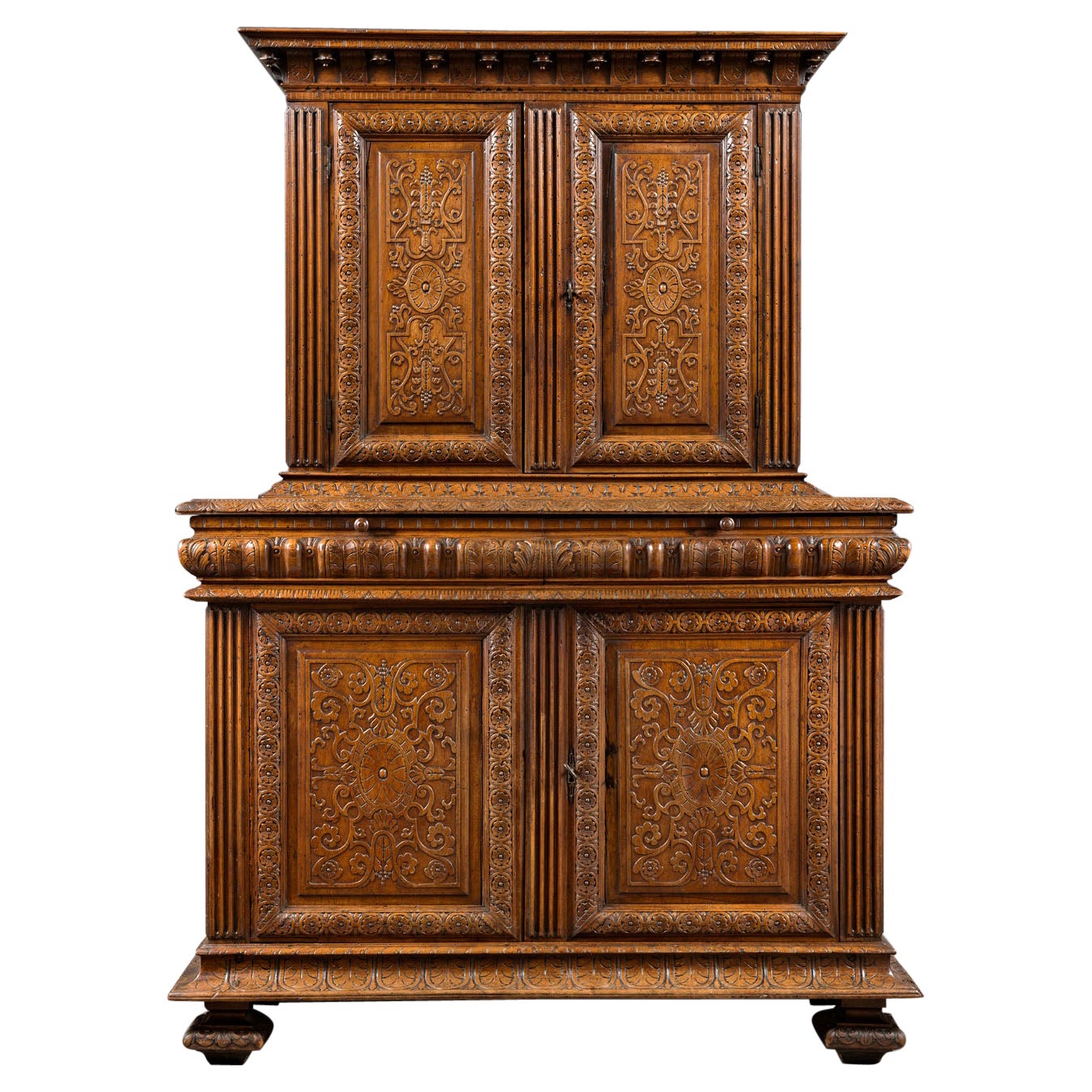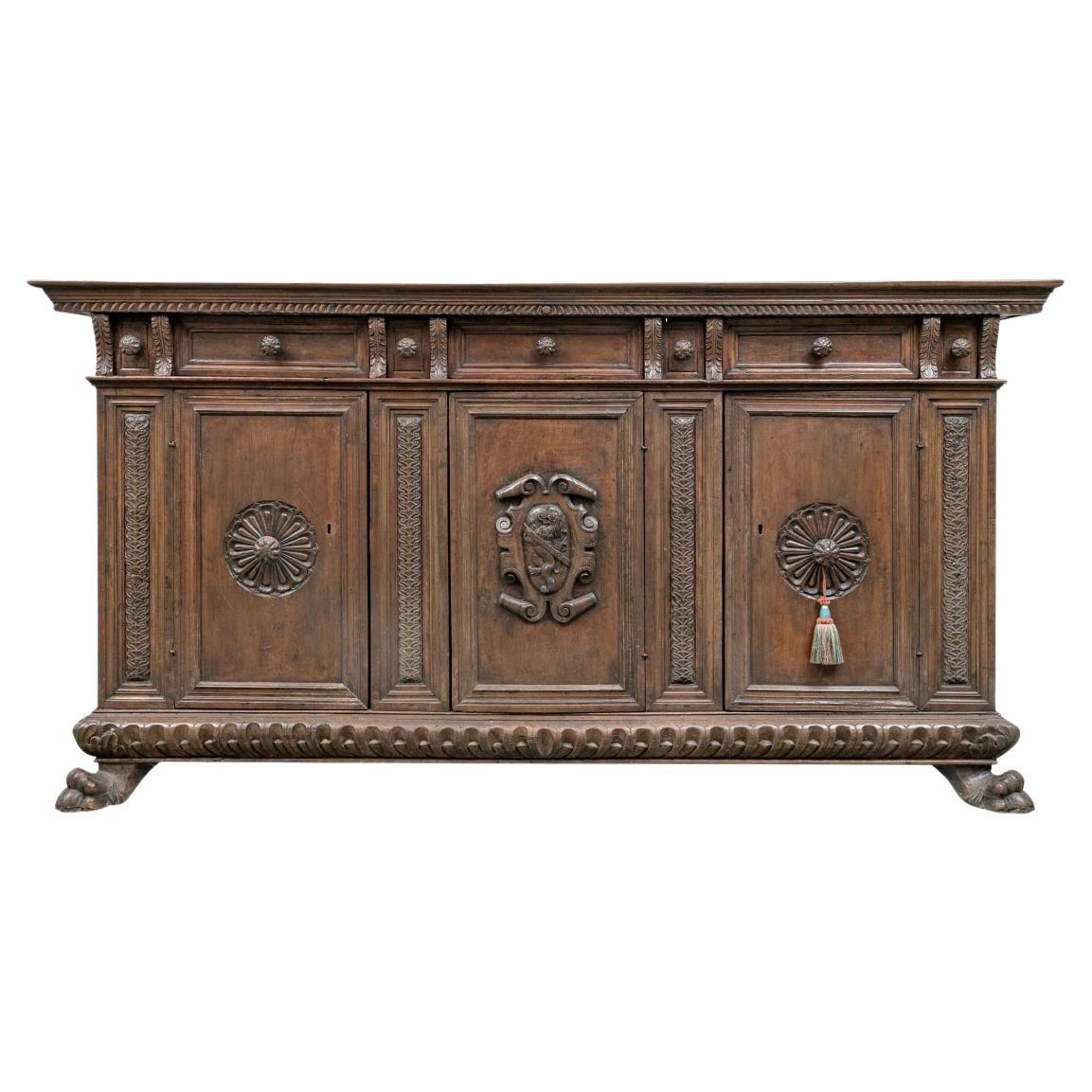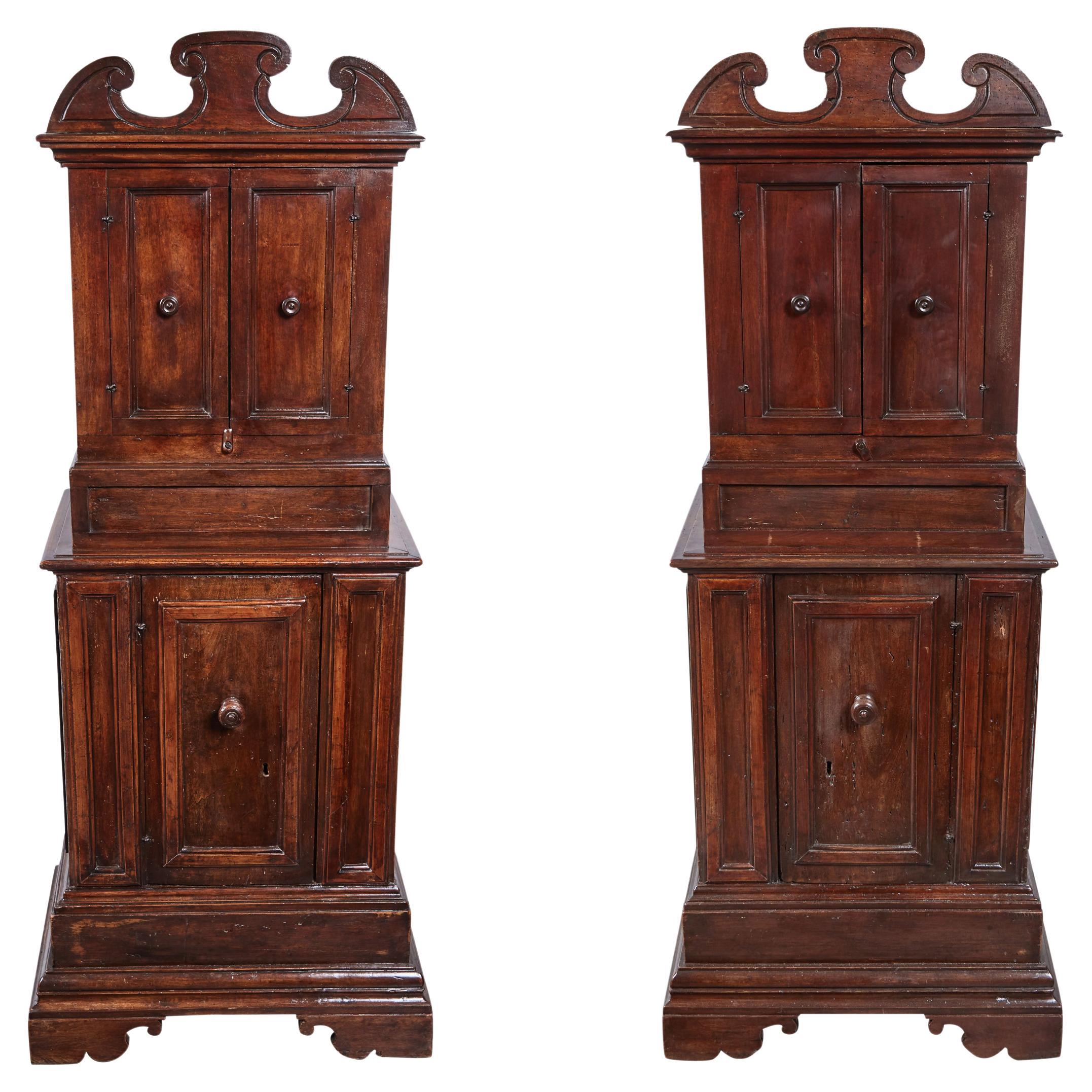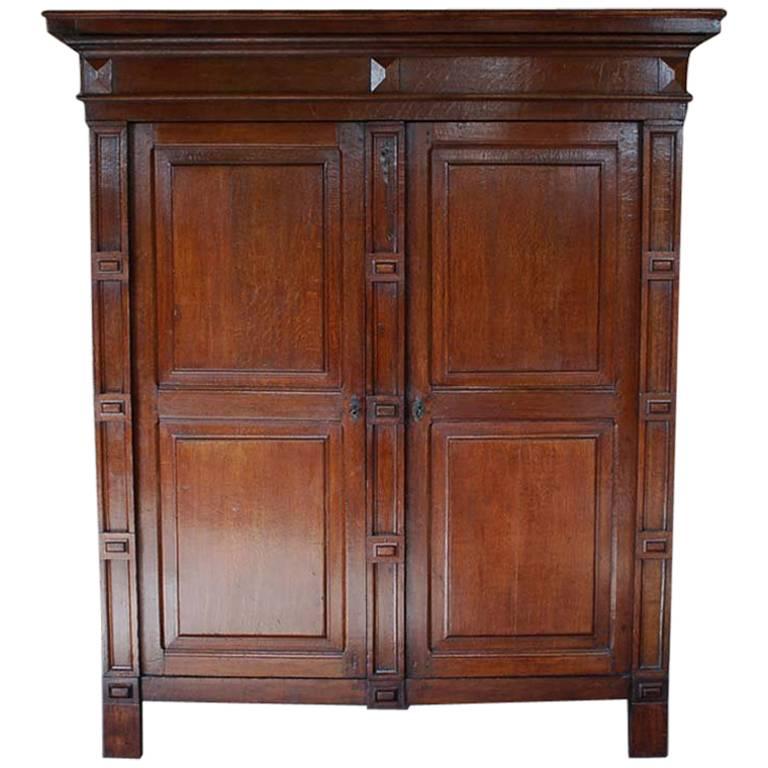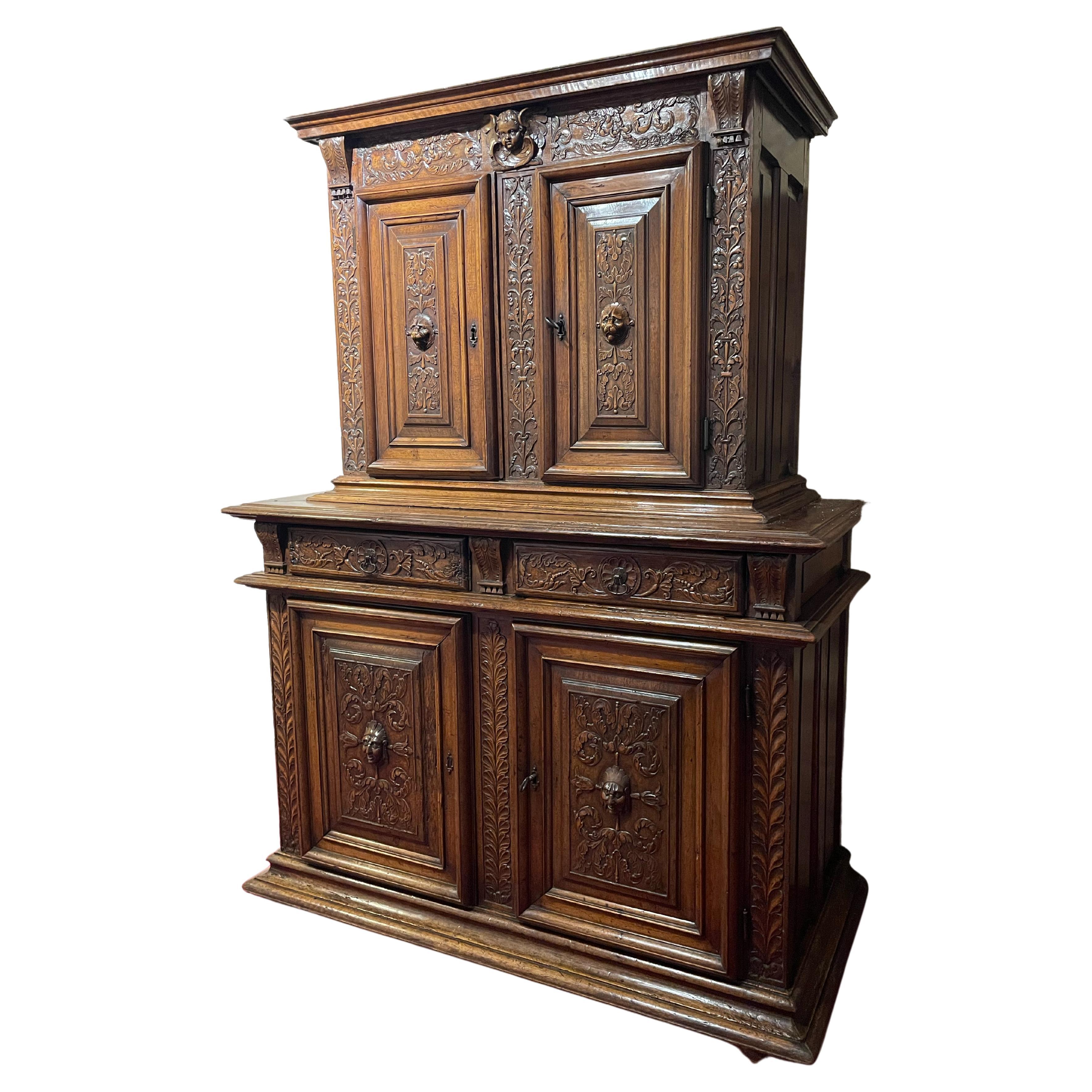Items Similar to Exceptional Renaissance Cabinet of Bellifontaine Inspiration
Want more images or videos?
Request additional images or videos from the seller
1 of 10
Exceptional Renaissance Cabinet of Bellifontaine Inspiration
About the Item
EXCEPTIONAL RENAISSANCE TWO-BODY CABINET OF BELLIFONTAINE INSPIRATION
ORIGIN: FRANCE, BURGUNDY
PERIOD: SECOND RENAISSANCE, AROUND 1560-1570
Height: 228 cm
Width: 129 cm
Depth: 57 cm
Blond walnut wood
Perfect state of preservation
Shortly before the second half of the 16th century, French furniture evolved considerably.
King François ler, after having fought in Italy, made a point of having the most beautiful pieces executed in France by Italian artists. This renaissance first took shape on the Fontainebleau building site, where the greatest artists of their time, especially Italians, worked together. They developed new, rich and inventive formulas. Their works and projects were distributed throughout Europe in the form of collections of engravings and prints. Le Rosso, Nicolo dell'Abate and Le Primatice transmitted the taste for the antique to the whole of France. Three theorist architects, Jacques Androuet du Cerceau (1510- 1585). Philibert de l'Orme (1510 - 1570), Jean Bullant (1520 - 1578), completed, through their writings, their works and numerous drawings, the contribution to this brand new inspiration which was to determine the structure and ornamentation of French furniture in the second half of the 16th century.
It was during the reign of King Henry II (1547-1559) and the regency of Catherine de Medici (1559-1589) that the general iconography of this furniture developed.
The structure of the furniture was transformed, taking its model from the Greek and Roman architecture that was then being revived. The furniture was also adorned with a new decoration, inspired by Bellifontan mannerism and marked by the study of the antique. The ornamental vocabulary evolves, following the antique taste: palmettes, volutes, acanthus, terms, pilasters and columns, eagles, rams' heads...
This cabinet, with its soberly architectural structure and richly sculpted decoration, is an admirable example of late 16th-century production, imbued with Italian, Bellifontan and antique influences. It opens with four leaves and two drawers in the belt.
THE LOWER BODY
Rising on a moulded base, the lower body follows a ternary rhythm. Three exceptional terms carved in high relief flank the leaves. The two male terms, with their powerful bodies and well-defined curls, carved on the side jambs, have draperies around their hips, on which are carved the heads of angels and lions. In the centre, the female term with a particularly elaborate hairstyle wears a heart-shaped necklace. On her draperies is a grimacing mask that hides the lock in its mouth.
Each of the panels, embossed in a moulded frame, presents stylised cut leather and acanthus leaves around a curved mirror. The two drawers in the belt are placed between three modillions decorated with a palmette.
THE UPPER BODY
The upper body, set back, follows the rhythm of the previous one. The terms also have the same physiognomy, although the male terms have a beautiful rolled-up moustache. They stand on sheaths decorated with palmettes, the ends of which curl into two small flowers.
The two panels, on the other hand, illustrate a mythological theme. Two deities are placed under niches, each surmounted by a majestic eagle, and resting on a Burgundian cabbage. On the right is a helmeted man. With his left hand he stands on his shield. This gives his posture a slight contrapposto. In his left hand he is holding the shaft of his spear. On the left, a woman is counterpointing him. She too is depicted naked, with an arrow in her right hand and a pierced heart in her left. The study of these two deities suggests that they are the mythological lovers Venus and Mars. The goddess has pierced the heart of the god of war, who is lowering his arms.
The piece of furniture is crowned by a pediment of exceptional quality, decorated with beautiful scrolled acanthus leaves and in its centre, the beautiful female mask.
THE SIDES
The sides are not left out. They are flanked by two stylised elements, one with a leafy body and a female face. The panels are carved in the centre with a rose window and moulded frames.
This work of sculpture, the accuracy of the composition and the respect of the proportions make this piece of furniture a perfect example of the achievements of the French huchiers during the second half of the 16th century. The presence of the god of war and the goddess of love on the leaves of the upper part of the cabinet suggests that it was made for a wedding and offered to the couple, thus celebrating their union.
The terms that punctuate the façade of this cabinet are reminiscent of the work of Hugues Sambin. This interest in the caryatid order was first seen in the stuccos of the Château de Fontainebleau before it became a real phenomenon following the publication in 1572, in Lyon, of the collection De la diversité des termes dont on utilise en architecture... by the Master from Dijon (active in Dijon from 1547 to 1583). The thirty-six figures drawn by Hugues Sambin were an inexhaustible source of inspiration for the huchiers. They used them in their work, adapting, modifying and reinterpreting them as they saw fit. This order, a resurgence of ancient art, is also one of the most important contributions of the second half of the 16th century.
The harmonious proportions, the pure lines, the sobriety and the quality of the ornamentation make this cabinet a work of exception.
BIBLIOGRAPHY
Jacqueline BOCCADOR, Le mobilier français du Moyen Age à la Renaissance, éditions d'art Monelle Hayot, 1988.
- Dimensions:Height: 64.57 in (164 cm)Width: 50.79 in (129 cm)Depth: 22.45 in (57 cm)
- Materials and Techniques:
- Period:
- Date of Manufacture:circa 1560-1570
- Condition:Repaired.
- Seller Location:Saint-Ouen, FR
- Reference Number:1stDibs: LU3115334524922
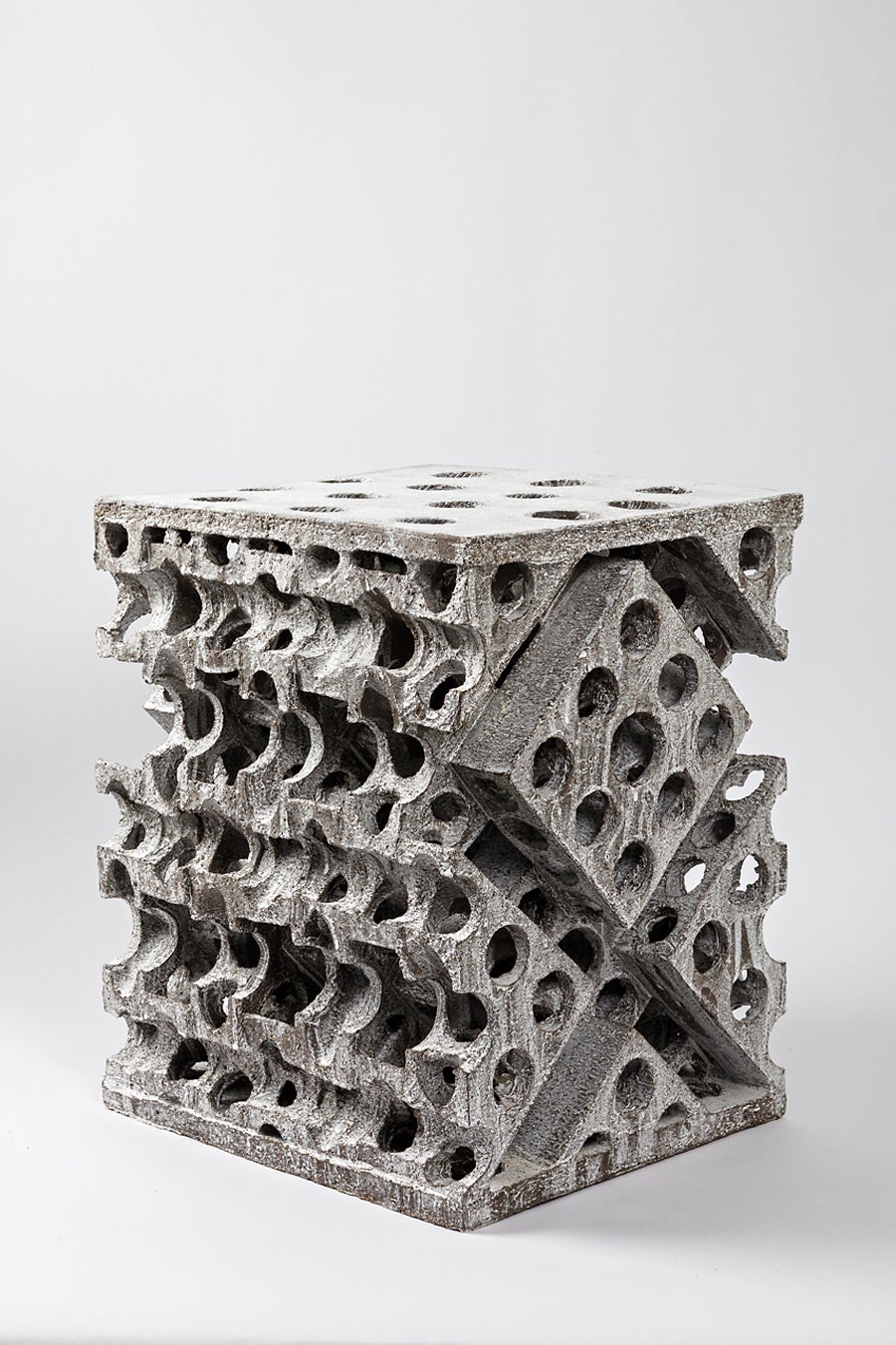
About the Seller
5.0
Vetted Seller
These experienced sellers undergo a comprehensive evaluation by our team of in-house experts.
Established in 2016
1stDibs seller since 2017
Typical response time: 8 hours
- ShippingRetrieving quote...Ships From: Paris, France
- Return PolicyThis item cannot be returned.
More From This SellerView All
- Exceptional Renaissance Cabinet from LyonLocated in Saint-Ouen, FRExceptional Renaissance Cabinet from Lyon Origin: Lyon, France Period: 1540-1580, Second French Renaissance Measures: Height: 188 cm Length: 132 cm ...Category
Antique 16th Century Cabinets
MaterialsWalnut
- Small Renaissance CabinetLocated in Saint-Ouen, FRSmall renaissance cabinet ORIGIN : FRANCE PERIOD : END OF THE 16th CENTURY Measures: height: 167 cm length: 123 cm depth: 58 cm This small two-part unit with harmonious proportions opens with four front leaves and two belt drawers. It rests on a molded base. The uprights and the central frame of the lower body are adorned with long stylized palmettes. They frame the four leaves on which unfolds a vegetal decoration made of stems and leaves sculpted in symmetry around two mascarons topped with feathers...Category
Antique 16th Century French Renaissance Cabinets
MaterialsWalnut
- Small Renaissance CabinetLocated in Saint-Ouen, FRSMALL RENAISSANCE CABINET ORIGIN: PROVENCE PERIOD: END OF THE 16th CENTURY Height: 175cm Length: 102cm Depth: 50cm Blond walnut This small cabin...Category
Antique 16th Century Cabinets
MaterialsWalnut
- Renaissance Cabinet form Lyon 'France'Located in Saint-Ouen, FRCondition : Partly dating from the Renaissance. The backs and the drawer’s insides have been re-done. Historical background The 16th century is a prosperous period for Lyon...Category
Antique 16th Century French Renaissance Cabinets
MaterialsWalnut
- Small Renaissance Cabinet from LyonLocated in Saint-Ouen, FRSmall renaissance cabinet from Lyon. ORIGIN: FRANCE, SCHOOL OF LYON PERIOD: 16th CENTURY Height:151cm Depth: 120cm Length: 54cm Walnut ...Category
Antique 16th Century Cabinets
MaterialsWalnut
- French Renaissance Cabinet with PerspectivesLocated in Saint-Ouen, FRThis Renaissance Cabinet reveals the great mastery of the Lyon workshops which are at the origin of its realization. Sculptors and wood-carvers worked here in symbiosis to express an...Category
Antique 16th Century French Renaissance Cabinets
MaterialsWalnut
You May Also Like
- Exceptional Large Antique Italian Renaissance Cabinet With Heraldic CrestLocated in Bridgeport, CTAn exceptional Renaissance style antique cabinet with imposing style and presence. Solid cabinet with a central door having a carved heraldic element flanked by two doors with carved...Category
Antique 19th Century Renaissance Cabinets
MaterialsHardwood
- Renaissance CabinetLocated in Washington, DCA truly stunning cabinet with a rich patina. Made by a Swedish cabinetmaker in the early 19th century. The paint on the inside and the outside is all original. Original hardware includes the hinges, locks, key, straps. Intricate carved paneling.Category
Antique Early 19th Century Swedish Renaissance Cupboards
MaterialsIron
- Pair of Renaissance Revival CabinetsLocated in Newport Beach, CAPair of walnut Renaissance Revival cabinets from a convent in Lucca, Italy. Hand painted interior of top section.Category
Antique Mid-19th Century Italian Renaissance Revival Cabinets
MaterialsWalnut, Paint
- Dutch Renaissance CabinetLocated in Casteren, NLRenaissance cabinet made from oakwood. Originates Netherlands, dating circa 1750.Category
Antique Mid-18th Century Dutch Cabinets
MaterialsOak
- Pair of Spanish Renaissance Style Mahogany CabinetsLocated in New York, NYPair of Spanish Renaissance style (19/20th Century) mahogany narrow cabinets with grill doors and red damask panel (PRICED AS Pair).Category
Antique Late 19th Century Renaissance Cabinets
MaterialsUpholstery, Mahogany
- Pair of English Renaissance Stained Oak CabinetsLocated in New York, NYPair of English Renaissance style (19/20th Century) dark stained oak carved 2 door sideboard cabinets with Wainscot panels and drawer (PRICED AS Pai...Category
Early 20th Century Renaissance Sideboards
MaterialsOak
Recently Viewed
View AllMore Ways To Browse
Moustache Mirror
Sculpted Antique Greece
Venus De Medici
Hugues Sambin
Ram Head Belt
Antique Heart Shaped Mirror
Angel Column Antique
Baker Black Lacquer Mirror
English Hamper
French Vintage Medicine Cabinet
Hugh Spencer
Philip Johnson On Sale
Red Laquer Chinese Furniture
Rolling Closet
Teak Stereo Console
Vintage Jbl Stereo Speakers
Vintage Map Flat File
Werkstatt Munchen
